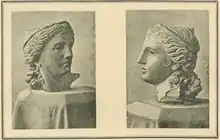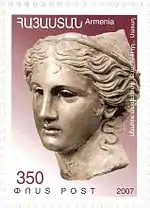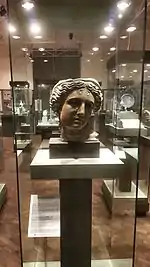Satala Aphrodite
Satala Aphrodite is the name given to the larger than life-size head of an ancient Hellenistic statue discovered in Satala (historical Armenia Minor, in present-day village of Sadak, Gümüşhane Province, Turkey). It was acquired by the British Museum in 1873 and is on display in the museum's Department of Greek and Roman Antiquities. Whether it depicts Greek Aphrodite or her Armenian equivalent Anahit is debated. It is usually dated around the 2nd–1st centuries BC.
| Satala Aphrodite | |
|---|---|
.jpg.webp) The head and hand of the Satala Aphrodite on display in the British Museum | |
| Material | Bronze |
| Size | head: 35.5 cm × 31 cm × 23.6 cm (14.0 in × 12.2 in × 9.3 in)[1] |
| Created | 4th–1st centuries BC, Asia Minor |
| Discovered | 1872 Satala (present-day Sadak, Gümüşhane Province, Turkey) |
| Present location | British Museum, Department of Greek and Roman Antiquities[2] |
Discovery
In 1872, a man digging his field near the village of Sadak, in what was once the ancient Roman fortress of Satala, on the Kelkit River, north of Erzincan,[3] uncovered several bronze statue fragments including a head and a hand. The head was acquired in Constantinople by Savas Kougioumtsoglou, a Greek antiquities dealer, who passed it to another dealer, Photiades, who took it to Rome, where it was sold to the art dealer Alessandro Castellani, who in turn sold it to the British Museum in 1873. The hand was donated to the museum three years later. The rest of the statue was never found.[2][4]
Description
The head weighs 10 kilograms (22 lb) and is between 35.5 cm (14.0 in)[1] and 38.1 cm (15.0 in)[2] high. The head and the hand belonged to a statue, from which they were removed. The back of the head is severely damaged, though the face has been largely preserved.[1] The top of the head was damaged during excavation. The eyes originally had either inlaid gemstones or glass.[2] The hand, which was found together with the head, holds a fragment of drapery.[1]
The head was first described by German archaeologist Richard Engelmann in 1878.[5][6]

Origin
The precise date and location of creation of the statue is debated. According to the British Museum it is from the first century BC.[2] James R. Russell suggests that it was probably cast in western Asia Minor in the 2nd–1st centuries BC.[3] Vrej Nersessian writes that it was probably created in Asia Minor in the mid-4th century BC.[1] Terence Mitford argued, based on its style, that it is a work of the "late Hellenistic or early Roman period".[7] He cites Reynold Higgins, who suggested that "it may be a cast from a mould made in c. 150 B.C., whether a Greek or Hellenistic original, or a Roman copy."[7] Brunilde Sismondo Ridgway writes that it is dated no earlier than the Augustan period.[8] Babken Arakelian argued based on a stylistic analysis that the head is similar to statues created in Asia Minor in the 2nd century BC.[9]

Aphrodite or Anahit
Vrej Nersessian writes that it has been "usually interpreted as representing Aphrodite."[1] However, it has also been attributed to Anahit,[10][11] the Armenian equivalent of Aphrodite, mainly because a temple dedicated to her at Erez (present-day Erzincan) was located nearby.[1][12] Satala, along with Erez, was located in the Acilisene province of Armenia Minor.[1][13] The first scholar to suggest that the head comes from a statue of Anahit was Ghevont Alishan in 1890.[14][6]
The British Museum website describes it as a "bronze head from a cult statue of Anahita in the guise of Aphrodite or Artemis."[2] Armenian scholar Mardiros Ananikian wrote in The Mythology of All Races (1925) that it is a "Greek work (probably Aphrodite), found at Satala, worshiped by the Armenians."[15] James R. Russell described it as "of the Greek Aphrodite type [...] believed to be from a statue of Anahit but more probably from a Roman temple."[3][16] Zhores Khachatryan, a leading Armenian archaeologist of the Hellenistic period, stated that "the Armenian origin of the statue still has to be proven." He believes that "it is more possible that it may be the statue of a Roman pagan goddess" as it was found near the site of a Roman camp inhabited during the time period its assumed creation.[17][18] Khachatryan had no doubt that it is a replica of Aphrodite of Knidos.[19] Dyfri Williams wrote that it comes from a Greek cult statue, "probably made in a Greek city in Turkey" and found at Satala (in Armenia Minor).[13] Terence Mitford suggests that it is "normally assigned to Aphrodite" and an attribution to Anaitis (Anahita) is "wholly implausible."[7] Babken Arakelyan found Artemis to be a more probable subject of the statue than Aphrodite.[20]

.png.webp)
Reception
In the west
As early as 1894 American art historian Arthur Frothingham described the bronze head as "one of the glories of the British Museum."[21] James R. Russell described it as a "piece of very fine workmanship."[3] The head appears on the cover of The Oxford History of Greece and the Hellenistic World (2002).[22] Peter Balakian authored a poem titled "Head of Anahit/British Museum", which was published in Poetry magazine in 2016.[23]
In Armenia
Babken Arakelyan considered it to be the most prominent of all Hellenistic statues found in Armenia.[20] A replica of the head is on display at the History Museum of Armenia in Yerevan since 1968.[24] It also appears on the 5,000 Armenian dram banknotes, which were in use from 1995 to 2005. The obverse side of the banknote depicted the Hellenistic Temple of Garni.[25] It was also depicted on a postage stamp issued jointly by Armenia and Greece in 2007.[26] Still Life with Anahit's Mask, a painting by Lavinia Bazhbeuk-Melikyan inspired by the head of Anahit, hangs at the President's Residence in Yerevan.[27]
Efforts to move to Armenia
In February 2012 Armen Ashotyan, then Minister of Education and Science of Armenia from the ruling Republican Party (RPA), called for moving the fragments of the statue to Armenia.[28] Ashotyan claimed it is a personal and not a political initiative.[17] By the end of February some 20,000 signatures were collected by the RPA-affiliated Armenia Youth Fund demanding moving the fragments to Armenia.[29][30] Some one hundred people demonstrated in front of the British embassy in Yerevan on March 7, 2012 chanting "Anahit, come home!" A letter was handed over to the embassy thanking the United Kingdom for preserving the fragments, but claimed that "historical justice requires" that they "be repatriated and find refuge in the country of their origin."[17] One proponent of the campaign argued that the "sentimental value of the goddess Anahit's statue is worth far more to the Armenians than to the tourists and visitors of the British Museum."[31]
Zhores Khachatryan, a leading Armenian archaeologist of the Hellenistic period, criticized the campaign as "pointless" and "populism that failed from the start." Head of the Ministry of Culture's Agency for the Preservation of Historical-Cultural Heritage, noted that the fragments were "not illegally exported from [Armenia], nor was it a war trophy, so that the ministry could try to return it with references to international treaties. It’s possible only as an act of good will."[17]
References
- Nersessian, Vrej (2001). "Bronze Head of Aphrodite/Anahit". Treasures from the Ark: 1700 Years of Armenian Christian Art. Los Angeles: J. Paul Getty Museum. pp. 114–115. ISBN 9780892366392.
- "The Satala Aphrodite". British Museum. Archived from the original on 11 April 2020.
- Russell, James R. (1987). Zoroastrianism in Armenia. Harvard University Press. p. 62. ISBN 0-674-96850-6.
- Burn, Lucilla (2004). Hellenistic Art: From Alexander the Great to Augustus. Getty Publications. pp. 87–88. ISBN 9780892367764.
- Engelmann, Richard (1878). "Ein Bronzekopf des British Museum". Archäologische Zeitung (in German). Berlin: German Archaeological Institute: 150–152.
- Margaryan 2003, p. 236.
- Mitford, T. B. (1974). "Biliotti's Excavations at Satala". Anatolian Studies. British Institute at Ankara. 24: 236. doi:10.2307/3642610. JSTOR 3642610.
- Ridgway, Brunilde Sismondo (2001). Hellenistic Sculpture, Volume 1. University of Wisconsin Press. p. 324. ISBN 9780299118242.
- Arakelian, B. N. (1971). "Հայկական մշակույթը հելլենիստական դարաշրջանում [Armenian culture during the Hellenistic period]". Հայ Ժողովրդի Պատմություն [History of the Armenian People] Volume I (in Armenian). Yerevan: Armenian Academy of Sciences. p. 874.
- Lang, David M. (1983). "Iran, Armenia and Georgia". In Yarshater, Ehsan (ed.). The Cambridge History of Iran, Volume 3 (1): The Seleucid, Parthian and Sasanian Periods. Cambridge University Press. p. 534.
A bronze head of Aphrodite/Anahit from Satala is in the British Museum.
- Lang, David Marshall (1980). Armenia: Cradle of Civilization. London: Allen & Unwin. p. 149.
All the more interest attaches to a singularly fine bronze head of Aphrodite/Anahit, which has been in the British Museum Greek and Roman Gallery for nearly a century. This head, which is about one and a half times life size, is from a colossal statue of Aphrodite/Anahit, reputedly from Satala, the modern Sadagh, in eastern Anatolia, not far from Erzinjan.
- Margaryan 2003, p. 235.
- Williams, Dyfri (2009). Masterpieces of Classical Art. University of Texas Press. p. 204. ISBN 9780292721470.
- Alishan, Ghevont (1890). Այրարատ [Ayrarat] (in Armenian). San Lazzaro degli Armeni. p. 40.
- Ananikian, Mardiros H. (1925). "Armenian". The Mythology of All Races Volume VII: Armenian and African. Boston: Archaeological Institute of America. pp. 26–27.
Bronze Head of Anahit, a Greek work (probably Aphrodite), found at Satala, worshiped by the Armenians
- Russell, J. R. (December 15, 1986). "Armenian Religion". Encyclopædia Iranica.
- Abrahamyan, Gayane (12 March 2012). "Armenia: Could a Goddess Influence an Election Campaign?". EurasiaNet. Archived from the original on 28 December 2019.
- Sakayan, Mano (18 July 2013). "The Curse of Anahit". Armenian Weekly. Archived from the original on 26 February 2018.
- Khachatryan, Zhores (1985). "Անահիտ դիցուհու պաշտամունքն ու պատկերագրությունը Հայաստանում և նրա աղերսները հելլենիստական աշխարհի հետ [The Cult and Iconography of Goddess Anahit in Armenia and Its Relations with the Hellenistic World]". Patma-Banasirakan Handes (in Armenian) (1): 128.
- Arakelyan, Babken (1969). "Քանդակագործությունը հին Հայաստանում (VI դ. մ. թ. ա.-III դ. մ. թ.) [Sculpture in Ancient Armenia (4th century BCE–3rd century CE]". Patma-Banasirakan Handes (in Armenian) (1): 62.
- Frothingham, Jr., A. L. (1894). "Archæological News". American Journal of Archaeology and of the History of the Fine Arts. 9 (3): 411. JSTOR 496192.
- Boardman, John; Griffin, Jasper; Murray, Oswyn, eds. (2002). The Oxford History of Greece and the Hellenistic World. Oxford University Press. ISBN 9780192801371. This book reproduces the text of The Oxford History of the Classical World: Greece and the Hellenistic World (1988, ISBN 978-0192821652)
- Balakian, Peter (September 2016). "Head of Anahit/British Museum". Poetry. Poetry Foundation.
- Madatyan, Marine (21 February 2012). "Արմեն Աշոտյանը խանդավառել է սփյուռքահայերին. արդեն 500 ստորագրություն կա". Hetq Online (in Armenian). Archived from the original on 11 April 2020.
1968թ.-ից արձանի կրկնօրինակը գտնվում է Հայաստանի պատմության թանգարանում:
- "Banknotes out of Circulation – 5000 drams". cba.am. Central Bank of Armenia. Archived from the original on 11 April 2020.
- "Armenian-Greek joint issue. Anahit". haypost.am. HayPost. Archived from the original on 11 April 2020.
- "Demonstration Areas". president.am. The Office to the President of the Republic of Armenia. Archived from the original on 10 May 2020.
- Gevorgyan, Siranuysh (6 February 2012). "Bring the Goddess Home: Education Minister launches initiative on returning divine Anahit to Armenia". ArmeniaNow. Archived from the original on 10 October 2012.
- "Group Calls on British Museum to Return Bronze Head of Goddess Anahit". Hetq. 12 February 2012. Archived from the original on 11 April 2020.
- "Armen Ashotyan is sure – "Anahit" Goddess to return to homeland". Armenpress. 7 March 2012. Archived from the original on 11 April 2020.
- Martirosyan, Gevorg (9 April 2012). "Campaign for Anahit's return to Armenia from British Museum". The Armenian Reporter. Archived from the original on 13 April 2012.CS1 maint: bot: original URL status unknown (link)
Bibliography
- Margaryan, Hasmik (2003). "Бронзовая голова Афродиты из Саталы [The Bronze Head of Aphrodite from Satala]". Patma-Banasirakan Handes (in Russian) (3): 235–246.CS1 maint: ref=harv (link)